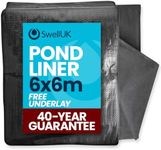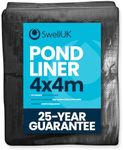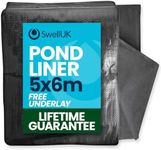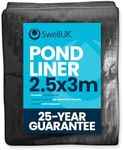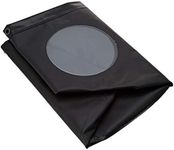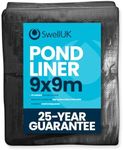Buying Guide for the Best Pond Liners
Choosing the right pond liner is crucial for creating a durable and leak-proof pond. The liner acts as a barrier to hold water in the pond, preventing it from seeping into the ground. When selecting a pond liner, consider the size and shape of your pond, the type of aquatic life you plan to support, and the environmental conditions in your area. A well-chosen liner will ensure the longevity and health of your pond ecosystem.MaterialThe material of a pond liner is important because it determines the liner's durability, flexibility, and resistance to punctures. Common materials include PVC, EPDM rubber, and polyethylene. PVC liners are lightweight and affordable, suitable for small to medium ponds. EPDM rubber is more flexible and durable, making it ideal for larger ponds or those with irregular shapes. Polyethylene is a cost-effective option for large ponds but may not be as flexible as EPDM. Choose a material based on the size of your pond and the level of durability you require.
ThicknessThickness is a key factor in a pond liner's durability and resistance to punctures. Thicker liners are generally more robust and can withstand more wear and tear. Thickness is usually measured in millimeters or mils, with common options ranging from 20 to 60 mils. For small decorative ponds, a thinner liner may suffice, while larger ponds or those with rocky or uneven surfaces may benefit from a thicker liner to prevent damage. Consider the environment and potential hazards when choosing the thickness.
SizeThe size of the pond liner must be sufficient to cover the entire pond area, including the depth and any shelves or ledges. It's important to measure your pond accurately and add extra material to account for overlap and anchoring. Liners are available in various pre-cut sizes, but custom sizes can also be ordered. Ensure the liner is large enough to accommodate your pond's dimensions to avoid leaks and ensure a proper fit.
UV ResistanceUV resistance is crucial for pond liners exposed to sunlight, as UV rays can degrade the material over time, leading to cracks and leaks. Liners with UV resistance are treated to withstand sun exposure, extending their lifespan. If your pond is in a sunny location, opt for a liner with high UV resistance to ensure it remains intact and functional for many years.
Fish and Plant SafetyIf you plan to have fish or aquatic plants in your pond, it's important to choose a liner that is safe for them. Some liners may contain chemicals or additives that can be harmful to aquatic life. Look for liners labeled as fish and plant safe, which are free from harmful substances. This ensures a healthy environment for your pond's inhabitants.

